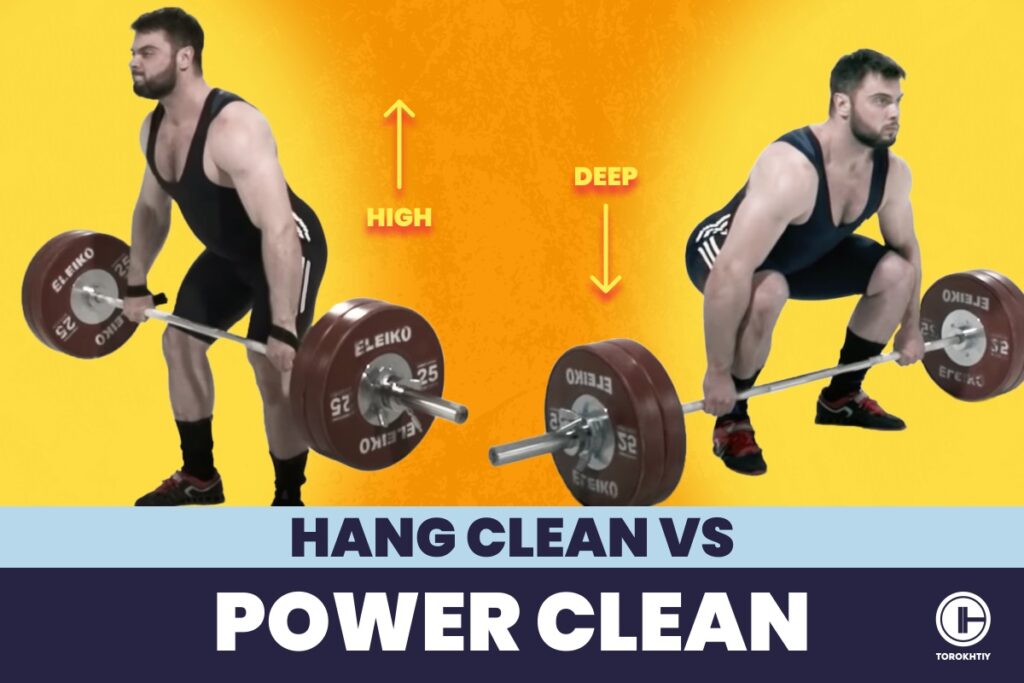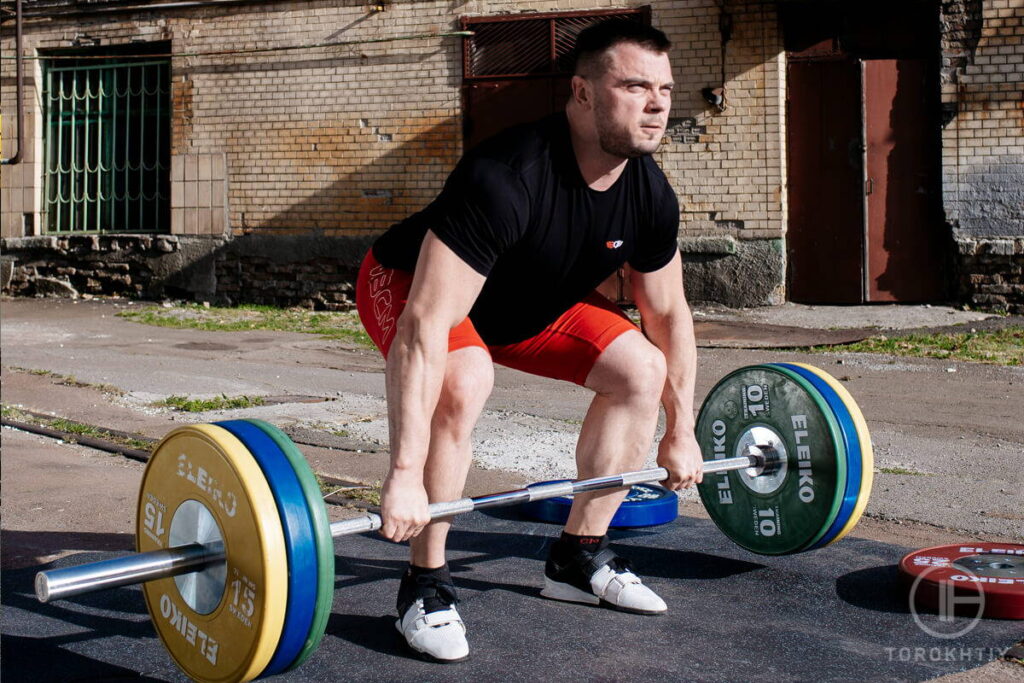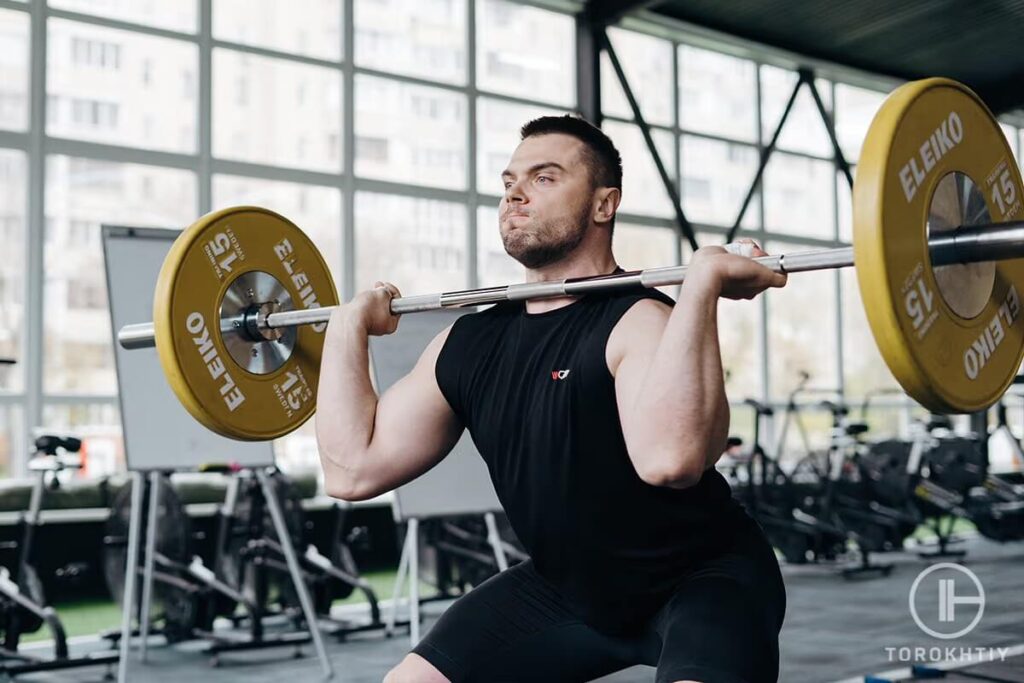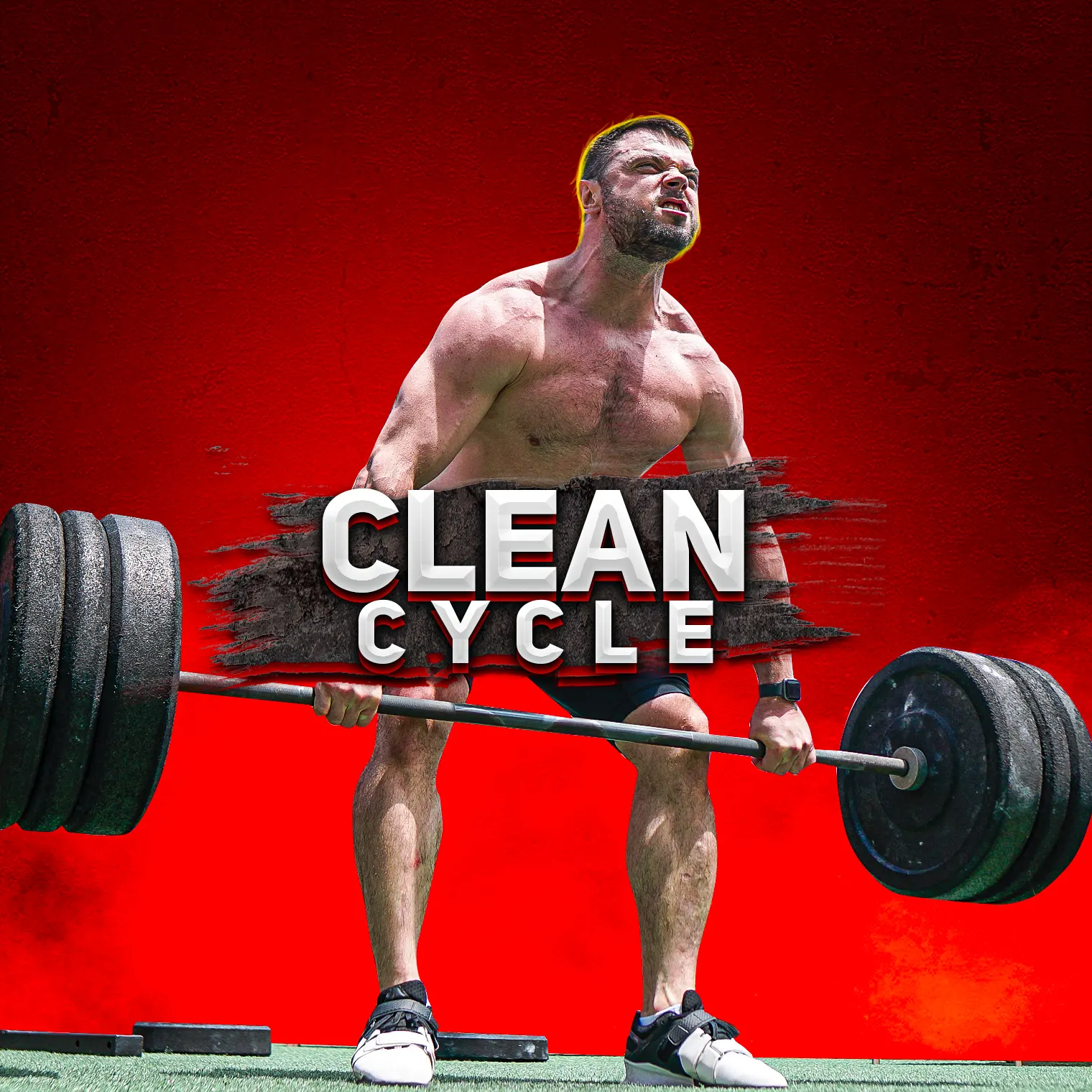Hang Clean vs Power Clean: Are They Any Different?
Author:
Reviewed by:
(21 years of Oly Lifting experience)
Unlock your full potential by engaging with our experts and community! Have questions about your fitness journey or looking for expert advice on weightlifting techniques? Don’t hesitate — leave a comment below and Sergii Putsov will provide a personalized answer and insights to help you reach your goals.
Torokhtiy is reader-supported. Some links are affiliate links, and we may earn a commission at no extra cost to you. See our disclosure page for details.
As far as building power goes, there are few exercises as effective as the clean. The hang clean and power clean are two variations of this incredible weightlifting workout. So are they any different? What’s the difference between them? Who wins the hang clean vs power clean matchup? We’ll find out in today’s article.
Hang clean vs power clean in short – they are different. If your target is your hips explosiveness, hang cleans are best. If you’re chasing strength and power, probably Power Clean would be better. The adaptation you achieve is likely to be determined by intensity and how you perform the exercise.
Now for the long answer, we must first understand each variation. First, the hang clean.

What Is A Hang Clean?
A full clean is a part of the Olympic clean and jerk exercise. To do a clean, you must pick a barbell from the floor and bring to your shoulders in a single, fluid motion.
There are some variations of the clean movement. One of these versions of the clean is called the hang clean.
A hang clean is a variation of the full clean workout that basically skips the first (starting) position and sometimes, in case of High Hang Clean – first pull. The move starts with the barbell already above the ground. You go straight to the second pull and catch.
The hang clean targets muscles all over your body. Biceps, triceps, and muscles in your shoulders and forearm are all heavily engaged. It also targets your lower back, hamstring, glutes, and hip muscles.
As great as it is, the thing with the hang clean is, you can generally lift less weight with it. This is because the movement starts with the barbell at or above the knees, which reduces the range of motion compared to starting from the floor. This can make it harder to generate the same amount of power and lift as much weight as in the power clean.
Sounds impressive, but the hang clean vs power clean matchup is far from over.
Pros And Cons Of The Hang Clean
Positives:
Could be better:
Follow us!

Free!
Get a 2-week Weightlifting Program as a bonus for the subscription to kickstart your training plan!

Free!
How To Do A Hang Clean?
The hang clean consists of different stages of movement.
- Start with the barbell above the ground ( below knees) or in case if high hang clean – at your thighs, above the knees, in a comfortable grip (usually shoulder-width). Keep your feet hip-width apart and your back straight. Your knees should be slightly bent and the hips pushed back. Keep your chest up and your gaze forward.
- Start the movement by engaging your hamstrings and glutes, extending your hips and knees to stand up. The barbell should stay close to your body as you lift.
- When the barbell reaches the middle of your thighs, extend your hips, knees, and ankles explosively to get upward momentum.
- As the barbell reaches its peak, quickly drop in a squat position by bending your knees and hips. Rotate your elbows under the bar to catch it on the front of your shoulders. Your upper arms should be parallel to the ground and your elbows should pint forward.
- Stand up straight from the squat position while keeping the barbell on your shoulders. Make sure you’re stable before completing the lift.
- Lower the barbell back by reversing the movement and keep it close to your body. Once the barbell is back at your thighs, you can prepare for the next rep.
You can see the hang clean in practice to get the full picture.
What is a Power Clean?
Like the hang clean, a power clean is a variation of the full clean. Unlike the hang clean, a power clean starts with the barbell on the floor.
Power cleans follow the same basic movement of a full clean. Pick the barbell from the floor, pull to your mid-thigh, then explode upwards and squat to catch it on your shoulders. There is only one difference: the squat depth when catching the barbell.
The power clean doesn’t require a full squat like the full clean. This means less movement, and makes power cleans easier to master.
The power clean is so popular because it’s essentially a full body workout. It works on the muscles in your shoulder, back, and stomach. It also targets muscles in your legs. Your calves, glutes, hamstring, and quads are all heavily engaged.
Pros And Cons Of Power Clean
Positives:
Could be better:
How To Do A Power Clean
A power clean involves essentially the same steps as a full clean.
- Starting position – Start with the barbell on the ground, positioned over the middle of your feet. Stand with feet hip-width apart and bend at the hips and knees to squat down and grab the barbell. Use a shoulder-width, hook grip. Keep your back straight, chest up, and gaze forward.
- 1st Pull – Extend your hips and knees to start the lift, and keep your back angle constant. Slowly lift the barbell off the ground while keeping it close to your body. The barbell needs to move vertically in a straight line.
- 2nd Pull – As the barbell passes your knees, shift your torso to a more upright position.
- Power position – When the barbell reaches the middle of your thighs, extend your hips, knees, and ankles explosively. At the same time, shrug your shoulders and pull the barbell up with your arms, with your elbows high and out to the sides.
- Turnover and Catch – As the barbell gets to peak height, quickly drop into a quarter/half squat position. Rotate the elbows underneath the barbell to catch it on the front of your shoulders. Your upper arms should be parallel to the ground, and your elbows should point forward.
- Recovery – Stand up straight from the half squat position while the barbell stays on your shoulders.
- Reverse the movement to lower the barbell back down.Bend at the hips and knees to place it back on the ground and keep your back straight throughout the descent.
Watch the power clean in action to get the full picture.
Hang Clean vs Power Clean: Head to Head
Now that we’ve settled the difference between hang clean and power clean, the next question is: which one is better for you?
To tackle this question, let’s look at a head to head comparison in some key areas.
1. Starting Position and Technique
The power clean starts from the floor and involves a full range of motion that includes both the first and second pulls. This makes it ideal for developing overall coordination because it engages the entire body.
On the other hand, the hang clean starts from the hang position, usually just above the knees. By focusing on the second pull, it isolates the explosive part of the lift and skips the initial pull. This makes the hang clean especially useful for refining technique and improving hip drive.
2. Difficulty
In terms of complexity, the power clean is more demanding because it includes the initial pull from the floor. This adds to the engagement of the lower back and introduces more stress due to the comprehensive movement.
Also, power cleans usually involve lifting heavier weights compared to hang cleans (however this depends on the athlete, low vs high hang clean etc).
The hang clean is “less” complex because it skips the first pull so there’s not as much initial stress on the lower back (also depends how you start). However, high hang clean involves lifting lighter weights, which places a higher emphasis on the whole posterior chain because of lack of momentum from regular clean.

3. Target and Benefits
The power clean is better for developing explosive power, strength, and coordination. It is especially beneficial for athletes who need to generate force from the ground, like sprinters, jumpers, and contact sport athletes.
It’s best used when you want to engage the entire body and improve power production from the ground up, so it’s a good component in strength training and conditioning programs aimed at building general strength and explosiveness.
The hang clean is better for improving the speed and power of the second pull, refining technique, and placing a higher focus on the posterior chain. It’s beneficial for athletes who need to work on their explosive hip drive and clean mechanics.
It’s ideal when you want to isolate and improve the explosive part of the lift, work on technique, or reduce the initial stress on the lower back. Hang cleans are also useful in training programs focused on enhancing specific aspects of the clean or improving the strength of the posterior chain.

FAQ
Which One Is Easier: Power Clean or Hang Clean?
The power clean involves the entire process of the full clean while the hang clean skips the first pull. This gives the impression that the hang clean is easier, but that’s not always the case.
The hang clean involves heavier weights and a full squat. By skipping the first pull, it also eliminates any momentum that you may have generated.
Like most things in fitness, there’s no clear answer.
Do Hang Cleans Make You Faster?
The hang clean focuses on developing explosive power. This power will make you stronger and faster. It will improve not just your speed, but your acceleration.
Are Hang Cleans Better Than Power Cleans?
Yet again, there is no clear answer to this. Much of it will depend on what your goals are. Hang cleans will help you lift heavier weights, master the explosion, and nail the squat.
Power cleans will help you improve explosive movement through various positions. They’ll help you nail your transitions and move faster.
Are Power Cleans Good for Football Players?
Power cleans start from the floor, which requires a greater range of motion and recruits more muscle groups, which emphasizes speed and power development. The extended range of motion will allow athletes to generate more focus and accelerate the barbell over a long distance, which can translate to better speed and power on the field.
Others will argue that there are better workouts to do for football players such as jumps, throws, and plyometrics.
Are Power Cleans Good for Vertical Jump?
Yes. Power cleans are all about generating explosive power from the ground right up in one fluid motion. That kind of power means you can run faster and jump higher.
Conclusion
The power clean vs hang clean comparison is a close one. Both are both incredible workouts that will help you get stronger and faster.
If you want to develop overall explosive power, strength, and coordination, go for the power clean. It’s ideal for athletes like sprinters, jumpers and contact sport athletes.
If you’d rather improve the speed and power of the second pull, refine technique, and focus on the posterior chain, the hang clean is your choice. It’s good for people who want to work on their explosive hip drive and clean mechanics.
In the end, both offer unique benefits depending on your training goals.
Now it’s your turn! Which version of the full clean is more attractive to you? Why will you pick one over the other? Have I missed anything? Tell me all of it in the comments!
Also read:
References:
- Triple Extension & Why It’s Important For Sprinting & Jumping // Ironworksperformance: https://www.ironworksperformance. com/post/sprint-faster.
- Photos are made by Torokhtiy Media team.
Why Trust Us?
With over 20 years in Olympic weightlifting, strength training, nutrition coaching, and general fitness our team does its best to provide the audience with ultimate support and meet the needs and requirements of advanced athletes and professional lifters, as well as people who strive to open new opportunities and develop their physical capabilities with us.
By trusting the recommendations of our certified experts in coaching, nutrition, and sports training programming, as well as scientific consultants, and physiotherapists, we provide you with thorough, well-considered, and scientifically proven content. All the information given in the articles concerning workout programming, separate exercises, and athletic performance, in general, is based on verified data.
The product testing process is described in more detail here.
Author: Sergii Putsov
Head of Sport Science, PhD
Best Results: Snatch – 165 kg,
C&J – 200 kg
Sergii Putsov, Ph.D., is a former professional weightlifter and National team member, achieving multiple medals in the 94 kg weight category at national competitions. With a Master’s degree in “Olympic & Professional Sport Training” and a Sport Science Ph.D. from the International Olympic Academy, Greece, Sergii now leads as the Head of Sport Science. He specializes in designing training programs, writing insightful blog articles, providing live commentary at international weightlifting events, and conducting educational seminars worldwide alongside Olympic weightlifting expert Oleksiy Torokhtiy.
Reviewed by: Oleksiy Torokhtiy
Olympic Weightlifting Champion
Best Results: Snatch – 200 kg,
C&J – 240 kg
Oleksiy Torokhtiy is a professional athlete boasting 20 years of experience in Olympic weightlifting. With multiple European and World titles under his belt, he has showcased his prowess in two Olympic Games (Beijing 2008 and London 2012). Upon concluding his illustrious career, Oleksiy dedicated himself to coaching. By 2022, he had conducted over 200 weightlifting seminars worldwide. He is the visionary behind an international sportswear and accessories brand known for its motto, “Warm Body Cold Mind.” Additionally, he is an esteemed author and the creator of a series of training programs and eBooks.





What about, Hang Power cleans?